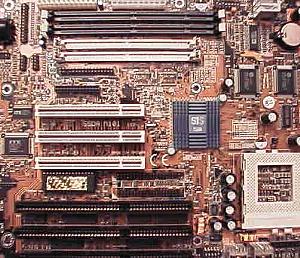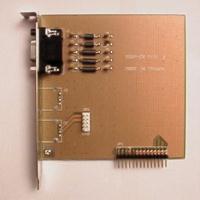| Socket Style: | Socket 7 |
| Chipset: | SiS 5598 |
| Cache: | 512KB |
| Form Factor: | AT (w/ AT & ATX PS Connectors) |
| BUS Speeds: | 50 / 55 / 60 / 66 / 68 / 75 / 83 MHz |
| Clock Multipliers: | 1.5x / 2.0x / 2.5x / 3.0x / 3.5x |
| Voltages Supported: | 2.8 / 2.9 / 3.2 / 3.38 / 3.5 |
| RAM Slots: | 2 168pin DIMM
Slots (EDO/SDRAM) 2 72pin SIMM Slots (EDO/FPM) |
| PCI/ISA Slots: | 3 PCI Slots 3 ISA Slots (0-Shared / 1-Full Length) |
| BIOS: | AWARD PnP BIOS |
| PCI EIDE Controller: | Super I/O 2 EIDE Channels 1 FDD Channel 2 Serial /1 EPP |
How could Chaintech possibly one-up ABIT with their 5SDA? This was the question Chaintech considered when designing the 5SDA, and by concentrating on ABIT's weaknesses and exploiting them to the best of their ability Chaintech produced a motherboard that could actually compete with the PD5N at more levels than one.
 |
Like the PD5N, the 5SDA is an AT form factor motherboard, however Chaintech included both AT and ATX Power Supply connectors to make the 5SDA as flexible as possible. Featuring 3 PCI and 3 ISA slots (none shared), the 5SDA isn't really designed for expandability however it doesn't absolutely forbid it with its spread out PCI/ISA slots. Back to the topic of focusing on ABIT's weaknesses, Chaintech decided to include 2 168-pin DIMM slots on the 5SDA in addition to the 2 72-pin SIMM slots which would be missed greatly if they weren't present simply because of the nature of the motherboard. The small footprint of the 5SDA ensures that it will be a perfect fit in nearly any case, ranging from the smallest desktop case to the largest tower. Based on SiS' new low cost integrated motherboard solution the 5598 chipset this particular motherboard brings a new set of features to the market, among those, an outstanding price. The SiS 5598 chipset also allows for a cacheable memory limit of 128MB as well as the following features (excerpt of The Chipset Guide): onboard VGA, UltraDMA support, SDRAM support, ACPI support. |
| The onboard VGA acceleration the 5SDA provides courtesy of the 5598 chipset is what really brings down the cost of any system based on this motherboard. As with the PD5N, the 5SDA allows you to use an external PCI video card if you choose to do so, however in the event that you don't wish to use an external accelerator you can simply use the onboard SiS VGA Controller. The bundled VGA Connector adapter, carefully disguised as any normal peripheral card, plugs into a proprietary feature connector port on the motherboard itself therefore enabling the onboard VGA function of the chipset...however not entirely. It is still up to the user to enable/disable the onboard VGA controller via a single dip switch that is either flipped on or off according to whether or not you have an external display adapter installed. Although this is simple enough, it doesn't seem like you will be able to use the onboard VGA accelerator in combination with any other graphics card in order to take advantage of a dual display system (a feature which will make its debut in Windows 98). It does seem unlikely though that you would be using a computer in an environment that would require multiple displays based on a low-end motherboard such as the 5SDA or any other SiS 5598 based offering. |  |
Chaintech has an excellent bundle with the 5SDA, including a CD including drivers for both the SiS 5598's Busmastering capabilities as well as the onboard VGA controller. Along with the CD is the newly renovated Chaintech manual which is slowly gaining its respect among the reviewers and well as users all around the world for being a amazing piece of work, truly an example what written documentation should be and a close rival of ABIT's own motherboard manual design.
Unlike most newer Chaintech motherboards, the 5SDA isn't jumperless, however not wanting to stray too far from their Jumperless nature Chaintech decided to use 2 sets of Dip-Switches with the 5SDA making the initial setup and configuration of the motherboard easier than if you were using cluttered sets of jumpers. That excellent manual of Chaintech's even includes documentation on Overclocking, although it expressly denounces it the manual provides the settings for the 75 and 83.3MHz bus frequencies. Another feature of the 5598 chipset is the ability to run the PCI bus asynchronously, meaning that regardless of your memory bus (66, 75, 83MHz etc...) the PCI bus will always run at a standard 33MHz to avoid any problems with peripherals that may crap out at higher PCI bus frequencies. Of course this feature can be disabled if all of your PCI devices work perfectly at higher bus speeds, however if you do experience erratic behavior this option is best left enabled. The 5SDA also has the ability to run the ISA Bus asynchronously at a the spec'd clock speed of approximately 7.159MHz, again this feature can be disabled via a setting in the comprehensive Award BIOS Setup utility.
Performance-wise the 5SDA is a little faster than ABIT's PD5N, however that could be attributed to the use of SDRAM in the tests with the 5SDA vs EDO in the PD5N's tests (since the PD5N doesn't support SDRAM). With a board like the 5SDA, you get what you pay for, don't expect 1st class performance, but then again don't expect the performance to be the worst you've ever seen. The video performance of the SiS accelerator of course is no where near the performance of a genuine Matrox Millennium, nonetheless you get what you pay for.
The problem with the Chaintech 5SDA is mainly that it isn't stable at frequencies above 262.5MHz due to a lack of high quality Sanyo/tantalum capacitors in spite of the sparing use of a few large electrolytic capacitors onboard. Also, the voltage regulator system used on the 5SDA has much room for improvement, while the 5SDA isn't suited for a high end - do or die environment considerations such as these are things that must be taken in order for a motherboard to be considered one of great quality and reliability.










1 Comments
View All Comments
sanju - Friday, February 10, 2017 - link
HI